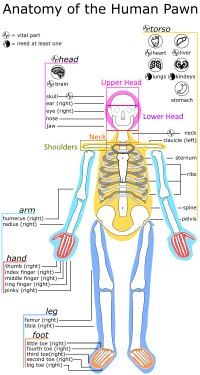Difference between revisions of "Clothing"
m (→Clothing) |
m (→Clothing: Added an important note about most clothing being sleeveless and some humor) |
||
| Line 28: | Line 28: | ||
<references/> | <references/> | ||
| + | |||
| + | <noinclude> | ||
| + | ==Sleeveless-ness== | ||
| + | Oddly enough, several pieces of apparel do not cover the arms. While sleeveless jackets and sleeveless T-Shirts are completely reasonable, the Button-Down Shirt and Duster are also sleeveless. This suggests that the Rimworlds have some sort of fascination with sleeveless apparel (not to mention that they also seem to be barren of any sort of pants/trousers). Massive oversight or a bizarre fashion trend? Who knows. | ||
| + | </noinclude> | ||
<noinclude> | <noinclude> | ||
{{:Clothing Layers}} | {{:Clothing Layers}} | ||
</noinclude> | </noinclude> | ||
Revision as of 09:05, 16 August 2014
Clothing
Clothes are a kind of gear, mostly for covering up your colonists nudity. They usually offer little in the way of protection when compared to armor.
| Name | Move Speed[1] | Layer[2] | Covers | Commonality[3] | Burn Res. | Bruise Res. | Shredded Res. | Cut Res. | Stab Res. | Gunshot Res. | Scratch Res. | Bite Res. | Crack Res. |
|---|---|---|---|---|---|---|---|---|---|---|---|---|---|
| T-Shirt | - | On Skin | Torso, Neck | 100% | - | 3% | 3% | - | - | - | 2% | 2% | - |
| Button-Down Shirt | - | On Skin | Torso, Neck | 100% | - | 3% | 3% | - | - | - | 2% | 2% | - |
| Tribalwear | - | Middle | Torso, Neck | 100% | - | 3% | 3% | - | - | - | 2% | 2% | - |
| Jacket | -3% | Shell | Torso, Neck | 50% | - | 8% | 8% | 5% | 5% | 2% | 2% | 3% | - |
| Duster | -4% | Shell | Torso, Neck | 50% | - | 8% | 8% | 5% | 5% | 2% | 2% | 2% | - |
| Cowboy Hat | - | Overhead | Upper Head | 70% | - | 3% | 3% | 3% | - | 15% | - | 15% | - |
Sleeveless-ness
Oddly enough, several pieces of apparel do not cover the arms. While sleeveless jackets and sleeveless T-Shirts are completely reasonable, the Button-Down Shirt and Duster are also sleeveless. This suggests that the Rimworlds have some sort of fascination with sleeveless apparel (not to mention that they also seem to be barren of any sort of pants/trousers). Massive oversight or a bizarre fashion trend? Who knows.
Each item of apparel or utility gear is worn on a specific location of the wearer's body. That location is determined by two things:
- The body part groups it covers.
- The layer or layers it occupies.
Apparel combinations are limited by layer and coverage - an item cannot be worn with another item that covers the same body parts and on the same layer. Thus, items covering the same parts but on different layers are compatible, as are items on the same layer but with no overlap in coverage. Items that cover multiple layers conflict with items on all layers.
Layers are also used to determine the order in which armor calculations are performed, with the outermost layer's armor applying first, and progressing through the layers until the attack is stopped or there are no more layers.
The layers, from innermost to outermost, are:
- Skin: The closest layer to the body, and mostly used for apparel below the head.
- Middle: The second closest layer to the body, and mostly used for apparel below the head.
- Outer: The third layer from the body, and mostly used for apparel below the head. Note that it will be displayed on the pawn's sprite above all other layers, even though it is considered below the following layers for actual mechanical effects.
- Belt: Technically the fourth layer. A distinct layer for utility items to allow them to be worn alongside any other apparel but not with each other.
- Headgear: The fifth layer, and used for headwear. There are several items that cover body parts typically covered by the other layers however, in which case this will be above them.
- Eyes: The outermost layer. A distinct layer only used for the blindfold
 to allow it to be worn alongside headwear.
to allow it to be worn alongside headwear.
Which body parts currently have items that occupy each of the layers is shown in the table on the below; layers and body parts which are not currently used by gear were omitted. As such, the hands and feet which are not covered by any apparel or any layer, are omitted.
Examples
- You can't wear pants as well as tribalwear, since both cover the "skin" layer and cover the legs.
- You can wear pants and a button-down shirt, since while they both use the "skin" layer they don't cover the same parts.
- You can wear pants and a duster, since while they both cover the legs pants use the "skin" layer while a duster uses the "outer" layer.
